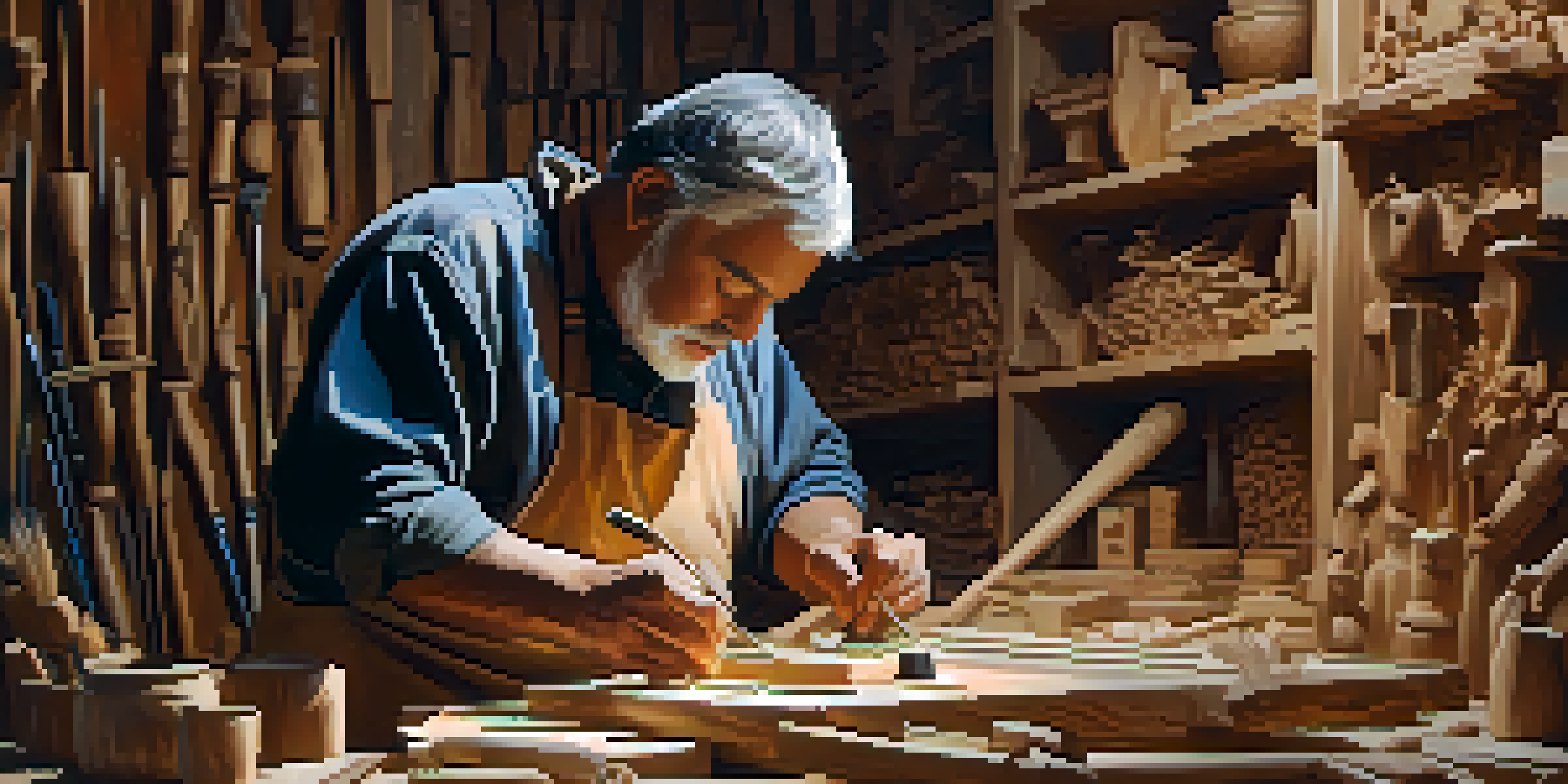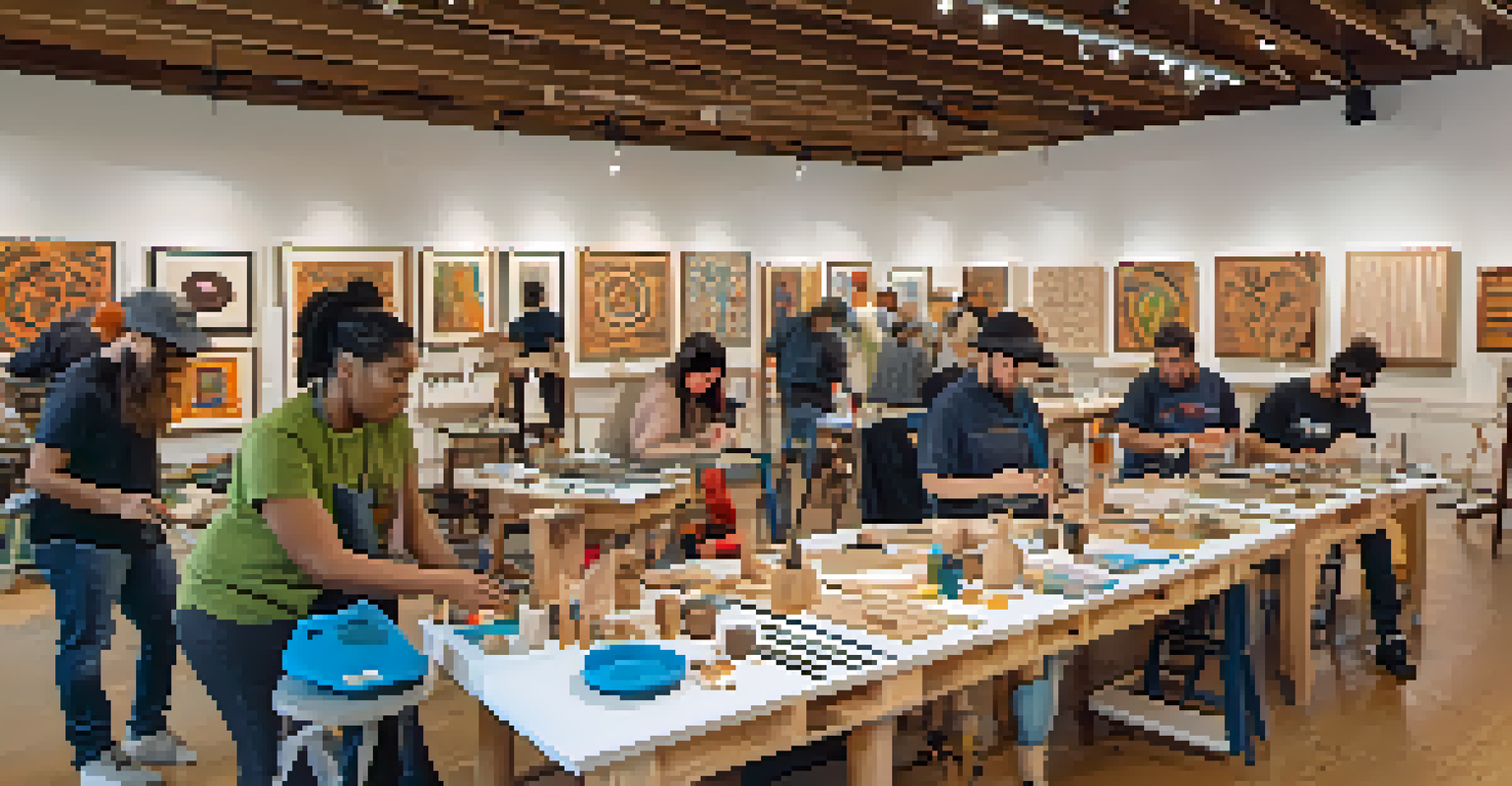The Evolution of Carving: Traditional Techniques Meet Digital

Understanding Traditional Carving Techniques and Their Roots
Carving dates back thousands of years, originating in ancient cultures where artisans used tools made of stone, bone, and wood. Techniques varied greatly across regions, influenced by local materials and cultural significance. For example, intricate wood carvings from Asia often tell stories or depict religious elements, showcasing the deep connection between art and tradition.
Art is not a thing; it is a way.
These traditional methods, like whittling and chip carving, require immense skill and patience. Craftsmen would spend countless hours perfecting their techniques, often passing knowledge down through generations. Such hands-on craftsmanship not only creates unique pieces of art but also fosters a sense of community among artisans.
As we dive into the world of carving, it's essential to appreciate these techniques and their historical context. Understanding where carving began helps us see how it has influenced modern practices, setting the stage for the exciting fusion of traditional and digital methods.
The Rise of Digital Technology in Art and Design
In recent years, digital technology has transformed the landscape of art and design, including carving. Tools like CNC (Computer Numerical Control) machines and 3D modeling software have opened new avenues for creativity. Artists can now create intricate designs with precision that would take weeks or months using traditional techniques.

This shift towards digital carving allows for experimentation that was previously unimaginable. Artists can easily modify designs, test ideas, and make adjustments on-the-fly, which fosters innovation. Imagine being able to create a complex sculpture in just a few clicks, rather than laboring over every detail by hand!
Traditional Techniques Shape Artistry
Understanding traditional carving techniques enhances appreciation for their historical context and influence on modern practices.
However, while digital tools offer efficiency, they also pose questions about authenticity and the value of hand-crafted work. As we explore the intersection of traditional and digital carving, it's crucial to consider these implications and how they shape the future of artistry.
Blending Traditional and Digital Techniques: A New Frontier
The fusion of traditional carving techniques with digital tools is a captivating phenomenon. Artists are now able to leverage the best of both worlds, merging the tactile experience of traditional methods with the precision of digital technology. Imagine carving a wooden sculpture by hand, then using a CNC machine to replicate intricate details seamlessly.
The true sign of intelligence is not knowledge but imagination.
This blending not only enhances creativity but also broadens the scope of what can be achieved. For instance, artists can carve a base piece traditionally and then use digital technology to create unique, complex patterns or textures that would be challenging to achieve manually. This collaboration of methods leads to innovative works that stand out in both craftsmanship and design.
As this new frontier continues to expand, it invites a conversation about the definition of art and craftsmanship. Are we losing the essence of traditional skills, or are we simply evolving to incorporate new tools and techniques? This dialogue is essential as we navigate the future of carving.
The Role of 3D Printing in Modern Carving Practices
3D printing has emerged as a game-changer in the world of carving, allowing artists to create complex forms with unprecedented ease. By designing a 3D model on a computer, artists can print their designs in various materials, from plastics to metals, providing opportunities for experimentation that traditional carving methods cannot offer. This technology can produce prototypes that help refine ideas before committing to the final piece.
Moreover, 3D printing can complement traditional carving by enabling artists to create intricate components that can be attached to hand-carved pieces. This approach enhances the overall design while maintaining the authenticity of the handcrafted element. Imagine creating a beautifully carved wooden statue adorned with finely printed details that add depth and dimension!
Digital Tools Revolutionize Carving
The rise of digital technology, including CNC machines and 3D printing, allows artists to blend precision with creative freedom.
However, the rise of 3D printing also raises questions about originality and craftsmanship. It challenges artists to redefine their roles and consider how they can maintain their unique voice in a landscape where technology plays such a significant role.
Preserving Cultural Heritage Through Modern Techniques
As digital carving techniques evolve, they offer exciting possibilities for preserving cultural heritage. Artists can use technology to replicate traditional artifacts, ensuring they are not lost to time. For instance, 3D scanning can capture the intricate details of historic carvings, allowing for accurate reproductions that can be displayed in museums or used for educational purposes.
This preservation effort goes beyond mere replication; it serves to educate future generations about the significance of traditional carving techniques and their cultural context. By merging technology with tradition, we create a bridge that connects the past to the present, fostering a deeper appreciation for the artistry involved.
However, this process also requires sensitivity and respect for the cultures being represented. Artists must navigate the fine line between honoring traditional practices and innovating in ways that resonate with contemporary audiences.
The Community of Carvers: Merging Experiences and Techniques
The carving community has always been a vibrant tapestry of shared experiences and techniques, and digital platforms have amplified this connectivity. Artists from around the world can now share their work, techniques, and tutorials online, creating a global dialogue that enriches the craft. This collaborative spirit fosters innovation and encourages artists to learn from one another, regardless of their location.
Online forums and social media have become essential spaces for discussion, where experienced carvers mentor newcomers and share best practices. For instance, YouTube is filled with tutorials that demystify complex carving techniques, making them accessible to anyone interested in learning. This open exchange of ideas empowers the next generation of artists to explore both traditional and digital methods.
Community Drives Innovation in Carving
The global carving community fosters collaboration through digital platforms, enriching the craft and encouraging knowledge sharing.
Through these connections, the carving community is evolving, with artists blending their diverse backgrounds and perspectives to create something entirely new. This communal approach not only enhances the craft but also builds relationships that transcend geographical boundaries.
Looking Ahead: The Future of Carving in a Digital Age
As we look ahead, the future of carving is filled with exciting possibilities and challenges. The integration of traditional techniques with digital technology will likely continue to grow, leading to even more innovative forms of art. Artists may find themselves experimenting with hybrid methods, combining hand-carving with digital enhancements to create unique pieces that reflect both heritage and modernity.
Moreover, advancements in technology, such as augmented reality and virtual reality, could introduce new dimensions to the carving experience. Imagine walking through a gallery where you can interact with digital carvings that respond to your movements, merging the physical and digital worlds in captivating ways.

Ultimately, the evolution of carving is a testament to the resilience and adaptability of artists. As they navigate this ever-changing landscape, they will continue to push boundaries, redefine craftsmanship, and inspire future generations to appreciate the art of carving in all its forms.